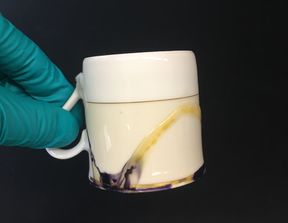Christina Stadlbauer, Ceramic Scar Tissue

Ceramic Scar Tissue
For the exhibition I selected pieces from my explorations on repair and healing. The works are part of my long-term research contextualized in Kin Tsugi - the traditional Japanese craft of mending ceramics. In Kin Tsugi, the crack or fault of the broken object is glued with a natural lacquer, called urushi, and finished with gold or silver. In contrast to other forms of repair that attempt to hide the damage, in Kin Tsugi the breakage is emphasized, and the transformation of the piece gives it additional value. The underlying philosophy of Wabi-sabi describes a world view centered around the acceptance of transience and imperfection.
Fascinated with this thought, I started to experiment in the microbiology lab of Biofilia. I wanted to explore the possibilities of talking the idea of repair into the living world along with concept of healing. Instead of gluing ceramics with urushi polymer, I wanted to enlist microbiological life as the `repairing agent`. The broken ceramic pieces get re-united by bacteria and the growth of a `scar tissue` joins the surfaces of the fragments. As bacteria alone have hardly any gluing capacity, I started to investigate genetic engineering as a method to adapt them for the task and make them become biological adhesives.
From this practice, a series of questions surfaced: When is something worth being repaired? What does the application of 'living' scar tissue to ceramics tell us about the meaning of healing as a transformational process by applying `living` scar tissue to ceramics? How can we justify using biological entities in the lab and deciding over their death at any given moment? What are the ethical implications and impact of synthetic biology and the use of genetically engineered material?
The presented work is an invitation to observe existing tensions between consumption and repair, but also to contemplate on how we approach bacteria as living entities or the meaning of healing that necessarily involves the experience of being broken.
Christina Stadlbauer combines art and research in her process-based and trans-disciplinary work. She obtained a PhD in Chemistry and has been inspired by themes around other-than-human life forms, including collective intelligence, interspecies communication and the relation between culture and nature. She has launched several long-term initiatives, like Melliferopolis – Bees in Urban Environments, and the Institute for Relocation of Biodiversity, which is an artistic platform to explore loss of habitat and biodiversity collapse. Christina works as an independent artist and creates installations, performances, publications and new rituals.
Since 2018, she has been conducting a series of laboratory experiments with bacteria, where she promotes the mending of objects through healing rather than gluing. With this, she questions habitual tendencies of how we assign value to our environment and proposes new views on cracks, faults and the impossibility of perfection.
Interview with Christina Stadlbauer
This interview is conducted with Christina Stadlbauer by Bilge Hasdemir as part of the Outre: Encounters with Non/living Things exhibition.







